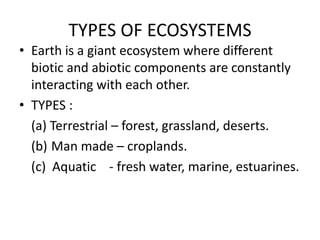
6377.types of ecosystems 10
- 1. TYPES OF ECOSYSTEMS • Earth is a giant ecosystem where different biotic and abiotic components are constantly interacting with each other. • TYPES : (a) Terrestrial – forest, grassland, deserts. (b) Man made – croplands. (c) Aquatic - fresh water, marine, estuarines.
- 2. FOREST ECOSYSTEM • Depends upon various factors such as annual rainfall, its distribution in different areas, mean temperature, relative humidity, total annual wet and dry period. • COMPONENTS : ABIOTIC – Inorganic, Organic litter, minerals. BIOTIC - Producers, primary consumers, secondary consumers, tertiary consumers and Decomposers.
- 3. PRODUCERS – Vegetation of the forest is the ra producer. All contains chlorophyll pigment and perform the process of photosynthesis. -Abiotic components are synthesized in the form of carbohydrates (food). PRIMARY CONSUMERS – Herbivores, insects, pests, birds, flies, spiders etc. SECONDARY CONSUMERS – Carnivorous animals like snakes, birds, fox, jackal etc. TERTIARY CONSUMERS – Top carnivores like lions, tigers, hawks etc. DECOMPOSERS – Microorganisms that recycles the nutrients.
- 4. GRASSLAND ECOSYSTEMS • Grasslands cover about 19% of the earth’s total surface. • ABIOTIC COMPONENTS – Nutrients such as C, N, H, O, P, S, etc. supplied by air and soil. • BIOTIC COMPONENTS – PRODUCERS- Herbs and shrubs. PRIMARY CONSUMER – Cattle, Rodents, Insects and all animals feeding on grass.
- 5. • SECONDARY CONSUMERS – Foxes, jackals, snakes, frogs, lizards, wild dogs etc. • TERTIARY CONSUMERS – Birds such as Hawks etc. • DECOMPOSERS – recharges the mineral contents of the soil and make it useful for farming.
- 6. DESERT ECOSYSTEMS • Deserts constitute about 17% of land, occurring in regions where annual rainfall is less than 25 cms. • Species composition is quite specific due to extreme climatic conditions. • BIOTIC COMPONENTS : PRODUCERS : Shrubs, some grasses, that have branched root system with stems and branches variously modified to reduce water loss. Eg. Cactus (Xerophytes)
- 7. • CONSUMERS : The most common are reptiles and insects able to live under xeric conditions. Some nocturnal rodents and birds. Camels “The ship of the desert “ feed on tender shoots of these plants. • DECOMPOSERS : Due to poor vegetation, the amount of organic matter available is less. Very few Thermophillic bacteria and fungi survive in such conditions.
- 8. CROPLAND ECOSYSTEMS • Artificial system aimed at growing a single species of own choice. Wheat, maize, rice, bajra, jowar, sugarcane, veget ables etc. • A no. of weeds also contribute like cynodon dactylon, euphorbia hirta, launaea nudicaulis etc. • COMPONENTS : ABIOTIC – Inorganic, Organic litter, minerals. BIOTIC - Producers, primary consumers, secondary consumers, tertiary consumers and Decomposers.
- 10. ZONES OF A LAKE • Littoral zone-The zone close to shore • Limnetic zone - This is the layer of open water where photosynthesis can occur. • Profundal zone - Many lakes (but few ponds) are so deep that not enough light reaches here to support net primary productivity.
- 11. MARINE ECOSYSTEMS • Marine ecosystems are among the largest of Earth's ecosystem. They include oceans, salt marsh and estuaries, mangroves, the deep sea and the sea floor, which have a higher salt content. • Marine waters cover two-thirds of the surface of the Earth. Such places are considered ecosystems because the plant life supports the animal life and vice-versa.
- 13. ESTUARINE ECOSYSTEM • Estuaries form a transition zone between river oceans and are subject to both marine influences, such as tides, waves, and the influx of saline water; and riverine influences, such as flows of fresh water and sediment. • The inflow of both seawater and freshwater provide high levels of nutrients and sediment, making estuaries among the most productive natural habitats in the world. • Act as breeding areas for deep water fishes.
